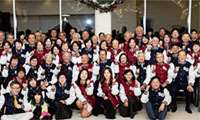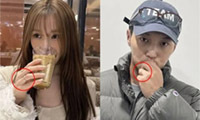BAGHDAD - The case of a freelance photographer in Iraq who was barred from covering the Marines after he posted photos on the Internet of several of them dead has underscored what some journalists say is an effort by the American military to control graphic images from the war.
Zoriah Miller, the photographer who took images of marines killed in a June 26 suicide attack and posted them on his Web site, was subsequently forbidden to work in Marine Corps-controlled areas of the country. Maj. Gen. John Kelly, the Marine commander in Iraq, is now seeking to have Mr. Miller barred from all United States military facilities throughout the world. Mr. Miller has since left Iraq.
If the conflict in Vietnam was notable for open access given to journalists - too much, many critics said, as the war played out nightly in bloody newscasts - the Iraq war may mark an opposite extreme: after five years and more than 4,000 American combat deaths, searches and interviews turned up fewer than a half-dozen graphic photographs of dead American soldiers.
While the Bush administration faced criticism for political manipulation in not permitting photos of flag-draped coffins, the issue is more emotional on the battlefield: local military commanders worry about security in publishing images of the American dead as well as an affront to the dignity of fallen comrades. Most newspapers refuse to publish such pictures .
But opponents of the war, civil liberties advocates and journalists argue that the public portrayal of the war is being sanitized and that Americans have the right to see the human cost of a war .
Journalists say it is now harder, or harder than in the earlier years, to accompany troops in Iraq on combat missions. And while publishing photos of American dead is not barred under the “embed” rules in which journalists travel with military units, the Miller case underscores that doing so, even under the rules, can result in expulsion from covering the war with the military.
“It is absolutely censorship,” Mr. Miller said. “I took pictures of something they didn’t like, and they removed me. Deciding what I can and cannot document, I don’t see a clearer definition of censorship.”
The Marine Corps denied it was trying to place limits on the news media and said Mr. Miller broke embed regulations. Security is the issue, officials said.
“Specifically, Mr. Miller provided our enemy with an after-action report on the effectiveness of their attack and on the response procedures of U.S. and Iraqi forces,” said Lt. Col. Chris Hughes, a Marine spokesman.
The facts of the Miller case are not in dispute . On June 26, Mr. Miller, 32, was embedded with Company E of the Second Battalion, Third Marine Regiment in Garma, in Anbar Province. The photographer declined a Marine request to attend a city council meeting, and instead accompanied a unit on foot patrol nearby.
When a suicide bomber detonated his vest inside the council meeting, killing 20 people, including 3 marines, Mr. Miller was one of the first to arrive. His photos show body parts littering the ground and heaps of eviscerated corpses. Mr. Miller said he spent three days on a remote Marine base editing his photos, which he then showed to the Company E marines. When they said they could not identify the dead marines, he believed he was within embed rules, which forbid showing identifiable soldiers killed in action before their families have been notified. According to records Mr. Miller provided, he posted his photos on his Web site on June 30, three days after the families had been notified.
The next morning, Marine public affairs officers demanded that Mr. Miller remove the photos. When he refused, his embed was terminated. On July 3, Mr. Miller was given a letter signed by General Kelly barring him from Marine installations.
The letter said that the journalist violated the embed rules that state that no information can be published without approval, including material about “any tactics, techniques and procedures witnessed during operations .”
“In disembedding Mr. Miller, the Marines are using a catch-all phrase which could be applied to just about anything a journalist does, said Joel Campagna, Middle East program coordinator for the Committee to Protect Journalists.
While embed restrictions do permit photographs of dead soldiers to be published once family members have been notified, in practice, photographers say, the military has exacted retribution on the rare occasions that such images have appeared. In one incident, Stefan Zaklin, formerly of the European Pressphoto Agency, was barred from working with an Army unit after he published a photo of a dead Army captain lying in a pool of blood in Falluja in 2004.
Even photos that do not portray soldiers’ deaths - but put the American military in an unfavorable light - are subject to official scrutiny. Chris Hondros, of Getty Images, was with an army unit in Tal Afar on January 18, 2005, when soldiers killed the parents of an unarmed Iraqi family. After his photos of their screaming blood-spattered daughter were published around the world, Mr. Hondros was kicked out of his embed .
For many in the military, a legal or philosophical debate over press freedom misses the point. Capt. Esteban T. Vickers of the First Regimental Combat Team, who knew two of the marines killed at Garma, said photos of his dead comrades desecrated their memory and their sacrifice.
“Mr. Miller’s complete lack of respect to these marines, their friends and families is shameful,” Captain Vickers said. “How do we explain to their children or families these disturbing pictures just days after it happened?”
Mr. Miller, who returned to the United States on July 9, expressed surprise that his images had ignited such an uproar.
“The fact that the images I took of the suicide bombing - which are just photographs of something that happens every day all across the country - the fact that these photos have been so incredibly shocking to people, says that whatever they are doing to limit this type of photo getting out, it is working, he said.
The United States military has tried to control graphic images from Iraq. An Iraqi girl is seen after her parents were killed by American gunfire in Tal Afar in 2005. Below, an American soldier shot dead in Falluja in 2004. Both photographers were barred from working with their military units.
스마터리빙
more [ 건강]
[ 건강]이제 혈관 건강도 챙기자!
[현대해운]우리 눈에 보이지 않기 때문에 혈관 건강을 챙기는 것은 결코 쉽지 않은데요. 여러분은 혈관 건강을 유지하기 위해 어떤 노력을 하시나요?
 [ 건강]
[ 건강]내 몸이 건강해지는 과일궁합
 [ 라이프]
[ 라이프]벌레야 물럿거라! 천연 해충제 만들기
 [ 건강]
[ 건강]혈압 낮추는데 좋은 식품
[현대해운]혈관 건강은 주로 노화가 진행되면서 지켜야 할 문제라고 인식되어 왔습니다. 최근 생활 패턴과 식생활의 변화로 혈관의 노화 진행이 빨라지고
사람·사람들
more많이 본 기사
- [특파원시선] 외식비 줄이는 미국… ‘30% 요구’ 팁 공포도 한몫?
- 아이비리그 브라운대서 총격…최소 2명 사망, 8명 중상
- 인도 투어 나선 축구스타 메시…경기장 조기 퇴장에 팬들 난동
- 정용진 신세계그룹 회장, 밴스 부통령 성탄절 만찬 참석
- 10석 안팎까지?…내년 한국 지방선거 때 ‘미니 총선급’ 재보선 가능성
- 지선 손 맞잡을까…통일교 특검으로 거리 좁히는 국힘·개혁신당
- 오세훈 “내집 마련 꿈, 10·15대책에 짓밟혀…규제 완화해야”
- 조미김, 미국 수출관세 ‘면제’됐다…K-김 최대시장서 날개
- 1124일만 선고.. ‘20억 횡령 인정’ 박수홍 친형 결론은?
- 변요한♥티파니, 약지에 ‘커플링·포르쉐’..열애 中 티냈다
- 뉴욕 백화점서 아기 기저귀 갈던 엄마, 정신질환자에 흉기피습
- “다카이치 ‘대만발언’은 對中전략 부재 탓…정상 만나야 해결”
- ‘김민재 점점 독일 국대에 밀린다’ 독일 현지, 타 향해 연일 찬사... “뮌헨 최고의 영입, 진정한 수비 리더”
- 트럼프, 시리아서 IS 공격으로 美병사 사망하자 “강력 보복”
- 연말연시 과음 후 속쓰림…단순숙취? “급성염증 신호일수도”
- ‘아프리카에 당한 기억’ 홍명보, ‘1승 제물’ 남아공 경계했다... 박문성도 “2014 월드컵 악몽 떠올라”
- AI 시장 흔들렸다…챗GPT 독주 속 제미나이 급부상
- 트럼프 “인디애나 선거구 조정 반대한 공화의원들, 교체돼야”
- 한소희, 韓 떠나기 전 의미심장 SN… 1
- ‘손흥민 벽화 3일 만에 그린’ 예술가, SON과 감격 만남 후 “내 아들의 영웅이자 아시아 유산” 찬사
- ‘인니 수마트라섬 대홍수’ 사망자 1천명 넘어…218명 실종
- ‘트럼프 골드카드’신청 시작, 100만달러 내면 미 영주권
- 국방부 “시리아서 공격받아 미군 2명 사망…공격범 사살”
- 김연아♥고우림, 사랑하니 닮아가네..예쁜 커플사진
- 트럼프 “인디애나 선거구 조정 반대한 공화의원들, 교체돼야”
- 송지효 “’런닝맨’ 출연 중 8년 ♥장기 연애했다” 폭탄 고백..멤버 모두 ‘충격’
- TV 나와 암투병 근황 공개한 찰스 英국왕… “조기검진 중요해요”
- 한화, 호주 방산업체 최대주주 된다
- 시리아서 미군 피격, 3명 사망… “시리아군 내 극단주의자 소행”
- 소셜연금 NY 2,018달러·NJ 2,190달러
- 韓 탁구 최초 역사… 신유빈-임종훈, 세계랭킹 1위+파리올림픽 金 듀오 꺾고 WTT 파이널스 우승
- 변요한♥티파니, 결혼 전제 열애 인정
- 신혼부부 ‘역대 최저’ 24%는 3억 이상 대출
- 굽히지 않는 젤렌스키…트럼프에 역제안 카드로 레드라인 저지
- “귀금속 역사상 가장 극적인 재평가”…올해는 銀이 金 앞섰다 [공준호의 탈월급 생존법]
- 내란특검, 김용현 추가 기소… “HID요원 등 명단 노상원에 넘겨”
- 종묘 일대 세계유산지구로 세운4구역 개발 영향 줄까
- 이정후 태극마크 ‘청신호’ 떴다! 스타 출신 SF 사장 “야수보단 투수가 WBC 위험”→걸림돌 사라졌다
- 선교사 아들 가나대사로 금의환향… “… 1
- “보안사고 반복 땐 과징금 폭탄”… 해킹과 전면전 선포한 과기부
- 뉴욕증시, 브로드컴 비관론에 AI 테마 ‘와르르’…나스닥 1.7%↓ 마감
- 김민선 학장 자선행사서 40만달러 기금조성
- 양로원 한인노인들에 온정 전해
- ‘정국 열애설’에 뿔난 아미 ‘워워’..BTS 완전체, 전역→웃으며 연습실 회동 첫 인증샷
- 한국 교사 10명, 페어팩스 초등교 배치
- 與, 은행법 처리뒤 ‘경찰관직무집행법’ 상정…국힘 또 필버
- “엔비디아, 中수요 반영 H200 증산”…일각선 “中, 수입거부할듯”
- “마약밀매·인신매매 등 국제범죄 척결” ‘국토안보 태스크포스’ 뉴욕지부 출범
- 기아 EV5, 넷플 ‘나이브스 아웃’ 협업 캠페인…세계 6개국 진행
- 국힘·개혁신당 “통일교 특검 수용하라”…與 “정치공세·물타기”
1/5지식톡

-
 테슬라 자동차 시트커버 장착
0
테슬라 자동차 시트커버 장착
0테슬라 시트커버, 사놓고 아직 못 씌우셨죠?장착이 생각보다 쉽지 않습니다.20년 경력 전문가에게 맡기세요 — 깔끔하고 딱 맞게 장착해드립니다!장착비용:앞좌석: $40뒷좌석: $60앞·뒷좌석 …
-
 식당용 부탄가스
0
식당용 부탄가스
0식당용 부탄가스 홀세일 합니다 로스앤젤레스 다운타운 픽업 가능 안녕 하세요?강아지 & 고양이 모든 애완동물 / 반려동물 식품 & 모든 애완동물/반려동물 관련 제품들 전문적으로 홀세일/취급하는 회사 입니다 100% …
-
 ACSL 국제 컴퓨터 과학 대회, …
0
ACSL 국제 컴퓨터 과학 대회, …
0웹사이트 : www.eduspot.co.kr 카카오톡 상담하기 : https://pf.kakao.com/_BEQWxb블로그 : https://blog.naver.com/eduspotmain안녕하세요, 에듀스팟입니다…
-
 바디프렌드 안마의자 창고 리퍼브 세…
0
바디프렌드 안마의자 창고 리퍼브 세…
0거의 새제품급 리퍼브 안마의자 대방출 한다고 합니다!8월 23일(토)…24일(일) 단 이틀!특가 판매가Famille: $500 ~ $1,000Falcon: $1,500 ~ $2,500픽업 & 배송직접 픽업 가능LA…
-
 바디프렌드 안마의자 창고 리퍼브 세…
0
바디프렌드 안마의자 창고 리퍼브 세…
0거의 새제품급 리퍼브 안마의자 대방출 한다고 합니다!8월 23일(토)…24일(일) 단 이틀!특가 판매가Famille: $500 ~ $1,000Falcon: $1,500 ~ $2,500픽업 & 배송직접 픽업 가능LA…
케이타운 1번가
오피니언

22기 LA평통 출범에 거는 기대

연말 시즌 사기·범죄 경계해야
 메건 매카들 워싱턴포스트 칼럼니스트
메건 매카들 워싱턴포스트 칼럼니스트 [메건 매카들 칼럼] 장편영화의 마지막 챕터인가
 김미선 서북미문인협회 회장시인
김미선 서북미문인협회 회장시인 [한국춘추] 하늘을 계산한 사람들, 칠정산
 이희숙 시인·수필가
이희숙 시인·수필가 [금요단상] 그을린 자리에서 다시
 심상용 / 서울대 미술관장
심상용 / 서울대 미술관장 [미술 다시보기] 지옥에 대하여
 서정명 / 서울경제 기자
서정명 / 서울경제 기자[만화경] 주한미군과 ‘도련선 리스크’
 한 영 재미수필가협회 회장
한 영 재미수필가협회 회장 [한영의 독서칼럼] 불안한 사람들
 정영현 서울경제 테크성장부장
정영현 서울경제 테크성장부장 [여명] 콘크리트가 데이터가 됐을 뿐, 달라진 게 없다
1/3지사별 뉴스

“마약밀매·인신매매 등 국제범죄 척결” ‘국토안보 태스크포스’ 뉴욕지부 출범
연방 국토안보부가 10일 ‘국토안보 태스크포스’(HSTF) 뉴욕지부를 출범시켰다.HSTF는 마약 카르텔, 인신매매, 자금세탁, 갱단 등 국제범…
‘오바마케어 보조금’ 올해 말 종료 가능성 ↑ 커져

한국 교사 10명, 페어팩스 초등교 배치
‘글로벌 앰버서더 티처스 프로그램’(Global Ambassador Teachers Program)은 국제 교사 교환 프로그램 가운데 하나로 …
김찬수씨, 포토맥 포럼에 2천달러 기부

트럼프 “인디애나 선거구 조정 반대한 공화의원들, 교체돼야”
도널드 트럼프 대통령은 13일 연방 하원의원 선거구 조정 표결에서 반대표를 던진 인디애나주 공화당 주(州) 상원의원들을 비판하며 당내 예비선거…
<부음> 이명무 전 SF 체육회장 부인상

오늘 하루 이 창 열지 않음 닫기 






















































.png)


댓글 안에 당신의 성숙함도 담아 주세요.
'오늘의 한마디'는 기사에 대하여 자신의 생각을 말하고 남의 생각을 들으며 서로 다양한 의견을 나누는 공간입니다. 그러나 간혹 불건전한 내용을 올리시는 분들이 계셔서 건전한 인터넷문화 정착을 위해 아래와 같은 운영원칙을 적용합니다.
자체 모니터링을 통해 아래에 해당하는 내용이 포함된 댓글이 발견되면 예고없이 삭제 조치를 하겠습니다.
불건전한 댓글을 올리거나, 이름에 비속어 및 상대방의 불쾌감을 주는 단어를 사용, 유명인 또는 특정 일반인을 사칭하는 경우 이용에 대한 차단 제재를 받을 수 있습니다. 차단될 경우, 일주일간 댓글을 달수 없게 됩니다.
명예훼손, 개인정보 유출, 욕설 등 법률에 위반되는 댓글은 관계 법령에 의거 민형사상 처벌을 받을 수 있으니 이용에 주의를 부탁드립니다.
Close
x